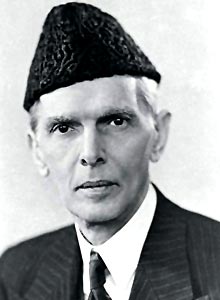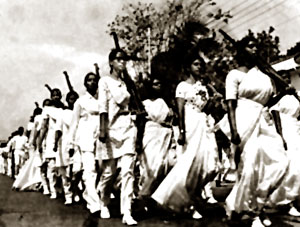 Unionist -League conflict is one of the well known conflicts which grew simultaneously along with the freedom struggle for India. The conflict took a vigorous form when in Jinnah declared the establishment of a league ministry in the province of Punjab. This automatically brought the province under the paramountcy of Muslim League giving a jerk to the Sikandar-Baldev Pact of 1942. Jinnah political plan of expansion over the area of Punjab disturbed the peace of the region as the Sikhs began to blame Sikandar for not giving value to the earlier pact which had assured them religious security in the face of a Muslim government.
Unionist -League conflict is one of the well known conflicts which grew simultaneously along with the freedom struggle for India. The conflict took a vigorous form when in Jinnah declared the establishment of a league ministry in the province of Punjab. This automatically brought the province under the paramountcy of Muslim League giving a jerk to the Sikandar-Baldev Pact of 1942. Jinnah political plan of expansion over the area of Punjab disturbed the peace of the region as the Sikhs began to blame Sikandar for not giving value to the earlier pact which had assured them religious security in the face of a Muslim government.
The Muslim league since 1942 had made enormous success in publicizing its demand for Pakistan. Among his other political campaigns, Jinnah`s campaign in the state of Punjab was the most alarming. The state of Punjab till now rested on some kind of compromise which was established through the Sikandar-Baldev Pact but this liaison got disturbed with Jinnah`s statement calling the Sikhs as a sub-national community. He further asserted in his Punjab tour that if the British could recognize India as a Hindu dominated nation then it should accept the right of the Muslims to self determination and should promise them give the areas through plebiscite. He further ridiculed the intension of the British rulers to give equal status like the Muslims to the other sub nationals like the Sikh communities. His statements only asserted that if the Hindu- Muslim conflict was an all India issue, the Muslim-Sikh question was only an issue concerning the state of Punjab. These statements reflected Jinnah`s opposition to the Sikandar -Baldev Pact which agitated the Sikh community simultaneously.
 Jinnah`s statements were condemned by the unionist leader who observed that these statements have shaken the foundation of the earlier pact which made the issue of Punjab an issue of provincial crisis .Simultaneously it forced them to enter into negotiations with Jinnah which again raised question on their alliance with the Hindus in the region. However, the talk between Muhammad Ali Jinnah and the Sikh leaders broke as neither Jinnah nor the Sikhs were prepared to come to any compromise. The Sikhs clearly mentioned that they were not prepared to live under the Muslim rule and even Jinnah was also not prepared to make any alteration regarding the boundaries of proposed boundaries of Pakistan.
Jinnah`s statements were condemned by the unionist leader who observed that these statements have shaken the foundation of the earlier pact which made the issue of Punjab an issue of provincial crisis .Simultaneously it forced them to enter into negotiations with Jinnah which again raised question on their alliance with the Hindus in the region. However, the talk between Muhammad Ali Jinnah and the Sikh leaders broke as neither Jinnah nor the Sikhs were prepared to come to any compromise. The Sikhs clearly mentioned that they were not prepared to live under the Muslim rule and even Jinnah was also not prepared to make any alteration regarding the boundaries of proposed boundaries of Pakistan.
One of the most visible features of this period was growing popularity of the Muslim League where it attracted a sufficiently large crowd with twenty to thirty thousand people attending the meetings. However, the League mainly attracted the urban middle class and could hardly influence the poor agro based farmers who formed the majority of the region.
The conflict got subsided to some extend with the demise of Sikandar Hayat Khan who died in December 1942. He was succeeded Khizar Hayat Khan Tiwana, son of Sir Umar Hyat Tiwana, one of the most richest land owner of the region. His honesty towards the British rulers had begun at the time of Non Cooperation Movement in 1919 when he forwarded his support to the British officers to control the movement. Although Khizar`s ability to confront Muhammad Ali Jinnah was doubted and he was considered too inexperienced to stand against the League leader, yet their relationship landed up into Sikandar - Jinnah pact .On a defensive Khizar had to accept the supremacy of Jinnah and during the All India Muslim League Conference held in Delhi in 1943 Khizar entered into a pact with Jinnah under which the active interference by the League in the areas of Punjab will be withdrawn through a resolution. Khizar further assured that he will do every thing regarding the propagation of League in Punjab; though he failed to create a separate League in Punjab which he said it was included in the terms of Sikandar-Jinnah Pact in which he will continue to remain the leader of such a provincial party in Punjab.
The differences between Khizar and Jinnah continued at the cost of the political stability in Punjab. Jinnah continued to blame Khizar for breaking the terms of the pact by not consulting the League in the selection of the prime minister. This only made the relationship bitterer within both the parties. The league continued to insist that the Unionist party should be dissolved as it only existed in name and not in function. The social status of the Unionist party was different from that of League while the Muslim Unionist party represented only the rich class of Zamindars, the League on the other hand was a peoples` party which represented the groups of cultivators, peasants and even landless farmers who formed the majority of the population.
Finally, the tussle between League and the Unionist party which was mainly divided into two phases with the initial phase being under the command of Sikandar Hayat Khan followed by the consecutive leaders of the Unionist Party, came to a halt with the creation of Punjab League which promised to safeguard the religious, cultural and spiritual traditions of the Muslims. The main aim was to attract the crowd of the Muslim tillers who formed the bulk of population in the area. This gave popular acceptance to the league leaving behind the age old Unionist party which now lacked proper representation.



















